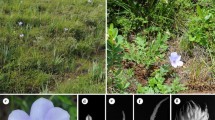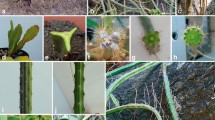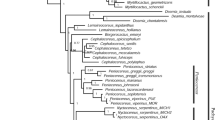Abstract
Phylogenies based on molecular characters has dominated publications rather than those based on morphological characters. Some authors have defended the use of morphology in phylogenetic reconstruction. In Cactaceae few studies have been made combining molecular and morphological characters. A good example about the use of morphology in phylogenetic analysis has been addressed in Echinocereus. Echinocereus is a morphologically diverse genus including 67 species that have been grouped into eight taxonomic sections based on morphological traits. Previous molecular phylogenetic analyses did not show entirely the relationships in Echinocereus species, and did not provide useful characters to recognize clades. Therefore, we performed a combined phylogenetic analysis with a set of 44 morphological characters and six chloroplast DNA sequences. Topologies from parsimony and Bayesian analyses resulted mostly congruent. However, relationships of E. poselgeri did not agree between analyses. A second bayesian analysis using long-branch extraction test resulted in a topology with a morphologically congruent position of E. poselgeri. Parsimony and Bayesian analyses corroborated the monophyly of Echinocereus, which included eight monophyletic groups. The clades did not recover the recent infrageneric classification. As a consequence, a new sectional classification for Echinocereus is proposed based on the eight recovered clades, which are supported by a combination of morphological and molecular characters. An identification key for sections in the genus is included.
Access this chapter
Tax calculation will be finalised at checkout
Purchases are for personal use only
Similar content being viewed by others
References
Agnarsson I, Miller JA (2008) Is ACCTRAN better than DELTRAN? Cladistics 24:1032–1038
Albesiano S, Terrazas T (2012) Cladistic analysis of Trichocereus (Cactaceae: Cactoideae: Trichocereeae) based on morphological data and chloroplast DNA sequences: dedicated to Omar Emilio Ferrari (1936–2010). Haseltonia 17:3–23
Anderson EF (2001) The cactus family. Timber Press, Portland
Arias S, Terrazas T, Arreola-Nava HJ et al (2005) Phylogenetic relationships in Peniocereus (Cactaceae) inferred from plastid DNA sequence data. J Plant Res 118:317–328
Assis L (2009) Coherence, correspondence, and the renaissance of morphology in phylogenetic systematics. Cladistics 25:528–544
Assis L, Rieppel O (2011) Are monophyly and synapomorphy the same or different? Revisiting the role of morphology in phylogenetics. Cladistics 27:94–102
Alves RJV, Machado MD (2007) Is classical taxonomy obsolete? Taxon 56:287–288
Baker M (2006a) A new florally dimorphic hexaploid, Echinocereus yavapaiensis sp. nov. (section Triglochidiatus, Cactaceae) from central Arizona. Plant Syst Evol 258:63–83
Baker M (2006b) Circumscription of Echinocereus arizonicus subsp. arizonicus, Phenetic analysis of morphological characters in section Triglochidiatus (Cactaceae) part II.Madroño 53:388–399
Bárcenas RT, Yesson C, Hawkins JA (2011) Molecular systematics of the Cactaceae. Cladistics 27:470–489
Berger A (1926) Die entwicklungslinien der Kakteen. Fisher, Jena
Bergsten J (2005) A review of long-branch attraction. Cladistics 21:163–193
Blum W, Felix D, Bauer H (2012) Echinocereus Die Sektion Echinocereus. Der Echinocereenfreund 25:1–336
Blum W, Felix D, Waldeis D (2008) Echinocereus Die Sektion Wilcoxia. Der Echinocereenfreund 21:1–142
Blum W, Lang M, Rischer M, Rutow J (1998) Echinocereus, Monographie. Selbstverlag, Aachen
Bollback JP (2006) SIMMAP: stochastic character mapping of discrete traits on phylogenies. BMC Bioinform 7:88
Bravo-Hollis H, Sánchez-Mejorada H (1991) Las Cactáceas de México [The cacti of Mexico], vol 2. Universidad Nacional Autónoma de México, Ciudad de México
Britton NL, Rose JN (1919) The Cactaceae, vol 1. Carnegie Institution of Washington, Washington
Britton NL, Rose JN (1920) The Cactaceae, vol 2. Carnegie Institution of Washington, Washington
Britton NL, Rose JN (1922) The Cactaceae, vol 3. Carnegie Institution of Washington, Washington
Britton NL, Rose JN (1923) The Cactaceae, vol 4. Carnegie Institution of Washington, Washington
Brown JM, Thomson RC (2017) Bayes factors unmask highly variable information content, bias, and extreme influence in phylogenomic analyses. Syst Biol 66:517–530
Butterworth CA, Cota-Sanchez JH, Wallace RS (2002) Molecular systematics of tribe Cacteae (Cactaceae: Cactoideae): a phylogeny based on rpl16 intron sequence variation. Syst Botany 27:257–270
Buxbaum F (1951) Morphology of cacti, section I: root and stems. Abbey Garden Press, Pasadena
Buxbaum F (1953) Morphology of cacti, section II: flower. Abbey Garden Press, Pasadena
Buxbaum F (1955) Morphology of cacti, section III: fruits and seeds. Abbey Garden Press, Pasadena
Buxbaum F (1958) The phylogenetic division of the subfamily Cereoideae, Cactaceae. Madroño 14:177–206
Calvente A, Zappi DC, Forest F et al (2011) Molecular phylogeny of tribe Rhipsalideae (Cactaceae) and taxonomic implications for Schlumbergera and Hatiora. Mol Phylogenet Evo 58:456–468
Cota JH (1993) Pollination syndromes in the genus Echinocereus: a review. Cact Succ J (US) 65:19–26
Cruz MÁ, Arias S, Terrazas T (2016) Molecular phylogeny and taxonomy of the genus Disocactus (Cactaceae), based on the DNA sequences of six chloroplast markers. Willdenowia 46:145–164
Cunningham WC, Omland KE, Oakley TH (1998) Reconstructing ancestral characters states: a critical reappraisal. Trends Ecol Evol 13:361–366
Darriba D, Taboada GL, Doallo R et al (2012) jModelTest 2: more models, new heuristics and parallel computing. Nat Methods 9:772
de Carvalho MR (1996) Higher-level elasmobranch phylogeny, basal squaleans, and paraphyly. In: Stiassny MLJ, Parenti LR, Johnson GD (eds) Interrelationships of Fishes 3. Academic Press, San Diego, pp 593–660
De Pinna MG (1991) Concepts and tests of homology in the cladistic paradigm. Cladistics 7:367–394
de Queiroz A, Donoghue MJ, Kim J (1995) Separate versus combined analysis of phylogenetic evidence. Ann Rev EcolSyst 26:657–681
Delsuc F, Henner B, Hervé P (2005) Phylogenomics and the reconstruction of the tree of life. Nat Rev Genet 6:361
Demaio PH, Barfuss MH, Kiesling R et al (2011) Molecular phylogeny of Gymnocalycium (Cactaceae): Assessment of alternative infrageneric systems, a new subgenus, and trends in the evolution of the genus. Am J Bot 98:1841–1854
Edwards EJ, Nyffeler R, Donoghue MJ (2005) Basal cactus phylogeny, implications of Pereskia (Cactaceae) paraphyly for the transition to the cactus life form. Am J Bot 92:1177–1188
Endler J, Buxbaum F (1974) Die Pflanzenfamilie der Kakteen, 3rd edn. A. Philler Verlag, Miden
Engelmann G (1848) Botanical appendix. In: Wislizenus FA (ed) Memoir of a tour to Northern Mexico, connected with Col. Doniphan’s Expedition, in 1846 and 1847, Tippin and Streeper, Washington, pp 87–115
Farris J (1979) The information content on the phylogenetic system. Syst Zool 28:483–519
Fuentes M (2004) Anatomía floral de algunas especies de Pachycereeae (Cactaceae) [Floral anatomy of some Pachycereeae species] (Unpublished bachelor dissertation). Facultad de Estudios Superiores Iztacala, Universidad Nacional Autónoma de México, Tlalnepantla
Gibson AC (1973) Comparative anatomy of secondary xylem in Cactoideae (Cactaceae). Biotropica 5:29–65
Gibson AC, Nobel PS (1986) The cactus primer. Harvard University Press, Cambridge
Goloboff PA, Farris J, Nixon K (2008) T.N.T. Tree analysis using new technology. Cladistics 24:774–786
Guerrero PC, Arroyo MTK, Bustamante RO et al (2011) Phylogentics and predictive distribution modeling provide insights into the divergence of Eriosyce subgen. Neoporteria (Cactaceae). Plant Syst Evol 297:113–128
Hernández-Hernández T, Hernández HM, De-Nova JA et al (2011) Phylogenetic relationships and evolution of growth form in Cactaceae (Caryophyllales, Eudicotyledoneae). Am J Bot 98:44–61
Hernández-Ledesma P, Bárcenas RT (2017) Phylogenetic utility of the trnH–psbA IGR and stem-loop diversity of the 3′ UTR in Cactaceae (Caryophyllales). Plant Syst Evol 1–17
Hughes CE, Lewis GP, Yomona AD et al (2004) Maraniona. A new dalbergioid legume genus (Leguminosae, Papilionoideae) from Peru. Syst Bot 29:366–374
Hunt DR (2012) Taxonomic implications of DNA studies relating to Cactaceae subfam. Cactoideae. Bull Int Cactaceae Syst Group 26:3–20
Hunt DR (2016) CITES Cactaceae checklist, 3rd edn. DH Books, Milborne Port
Hunt DR, Taylor NP, Charles G (2006) The new cactus lexicon. DH Books, Milborne Port
Jenner R (2004) Accepting partnership by submission? Morphological phylogenetics in a molecular millenium. Syst Biol 53:333–342
Kluge AG (1989) A concern for evidence and phylogenetic hypothesis for relationships among Epicrates (boide, Serpentes). Syst Zool 38:1–25
Knopf P, Schulz C, Little DP et al (2012) Relationships within Podocarpaceae based on DNA sequence, anatomical, morphological, and biogeographical data. Cladistics 28:271–299
Kolaczkowski B, Thornton JW (2009) Long-branch attraction bias and inconsistency in Bayesian phylogenetics. PLoS ONE 4:e7891
Korotkova N, Borsch T, Arias S (2017) A phylogenetic framework for the Hylocereeae (Cactaceae) and implications for the circumscription of the genera. Phytotaxa 327:1–46
Korotkova N, Borsch T, Quandt D et al (2011) What does it take to resolve relationships and to identify species with molecular markers? An example from the epiphytic Rhipsalideae (Cactaceae). Am J Bot 98:1549–1572
Larridon I, Walter HE, Guerrero PC et al (2015) An integrative approach to understanding the evolution and diversity of Copiapoa (Cactaceae), a threatened endemic Chilean genus from the Atacama Desert. Am J Bot 102:1506–1520
Lartillot N, Brinkmann H, Philippe H (2007) Suppression of long-branch attraction artefacts in the animal phylogeny using a site-heterogeneous model. BMC EvolBiol 7:S4
Lartillot N, Philippe H (2004) A bayesian mixture model for across-site heterogeneities in the amino-acid replacement process. Mol Biol Evol 21:1095–1109
Lewis PO (2001) A likelihood approach to estimating phylogeny from discrete morphological character data. Syst Biol 50:913–925
Loza-Cornejo S, Terrazas T (1996) Anatomía del tallo y raíz de dos especies de Wilcoxia Britton & Rose (Cactaceae) del noreste de México. Bol Soc Bot México 59:13–23
Luna E, Mishler BD (1996) El concepto de homología filogenética y la selección de caracteres taxonómicos. Bol Soc Bot México 59:131–146
Majure LC, Puente R, Griffith MP et al (2012) Phylogeny of Opuntia s.s. (Cactaceae): clade delineation, geographic origins, and reticulate evolution. Am J Bot 99:847–864
Nixon KC (2002) WinClada, version 1.00. 08. Ithaca, NY
Nixon KC, Carpenter JM (1996) On simultaneous analysis. Cladistics 12:221–241
Nixon KC, Carpenter JM (2000) On the other “phylogenetic systematics”. Cladistics 16:298–318
Nixon KC, Ochoterena H (2000) Taxonomía tradicional, cladística y construcción de hipótesis filogenéticas. In: Hernández HM, García Aldrete AN, Álvarez F et al (eds) Enfoques contemporáneos para el estudio de la biodiversidad. Universidad Nacional Autónoma de México & Fondo de Cultura Económica, Ciudad de México, pp 15–37
Norup MV, Dransfield J, Chase MW et al (2006) Homoplasious character combinations and generic delimitation: a case study from the Indo-Pacific arecoid palms (Arecaceae: Areceae). Am J Bot 93:1065–1080
Nyffeler R (2002) Phylogenetic relationship in the cactus family (Cactaceae) based on evidence from trnK/matK and trnL-trnF sequences. Am J Bot 89:312–326
Nyffeler R, Eggli U (2010) A farewell to dated ideas and concepts: molecular phylogenetics and revised suprageneric classification of the family Cactaceae. Schumannia 6:1–42
Nylander JAA, Ronquist F, Huelsenbeck JP et al (2004) Bayesian phylogenetic analysis of combined data. Syst Biol 53:47–67
Ochoterena H (2009) Homology in coding and non-coding DNA sequences, a parsimony perspective. Plant Syst Evol 282:151–168
Patterson C (1982) Morphological characters and homology. Problems of phylogenetic reconstruction. Academic Press, London
Pol D, Siddall ME (2001) Biases in maximum likelihood and parsimony, a simulation approach to a 10-taxon case. Cladistics 17:266–281
Richards R (2003) Character individuation in phylogenetic inference. Philo Sci 70:264–279
Rindal E, Brower AV (2011) Do model-based phylogenetic analyses perform better than parsimony? A test with empirical data. Cladistics 27:331–334
Ritz CM, Martins L, Mecklenburg R et al (2007) The molecular phylogeny of Rebutia (Cactaceae) and its allies demonstrates the influence of paleogeography on the evolution of South American Mountain cacti. Am J Bot 94:1321–1332
Ronquist F, Huelsenbeck JP (2003) MRBAYES 3, Bayesian phylogenetic inference under mixed models. Bioinformatics 19:1572–1574
Sánchez D, Arias S, Terrazas T (2013) Análisis morfométrico de las especies de Echinocereus sección Triglochidiati (Cactaceae) en México. Brittonia 65:368–385
Sánchez D, Arias S, Terrazas T (2014) Phylogenetic relationships in Echinocereus (Cactaceae, Cactoideae). Syst Bot 39:1183–1196
Sánchez D, Grego-Valencia D, Terrazas T et al (2015) How and why does the areole meristem move in Echinocereus (Cactaceae)? Ann Bot 115:19–26
Sánchez D, Terrazas T, Grego-Valencia D, Arias S (2018) Phylogeny in Echinocereus (Cactaceae) based on morphological and molecular evidence: taxonomic implications. Syst Biodivers 1:28–44
Schlumpberger BO, Renner SS (2012) Molecular phylogenetics of Echinopsis (Cactaceae), polyphyly at all levels and convergent evolution of pollination modes and growth forms. Am J Bot 99:1335–1349
Schumann K (1899) Gesamtbeschreibung der Kakteen. Neudamm, Berlin
Scotland RW, Olmstead RG, Bennett JR (2003) Phylogeny reconstruction, the role of morphology. Syst Biol 52:539–548
Simmons MP, Ochoterena H, Carr TG (2001) Incorporation, relative homoplasy, and effect of gap characters in sequence-based phylogenetic analyses. Syst Biol 50:454–462
Smith ND, Turner AH (2005) Morphology’s role in phylogeny reconstruction: perspectives from paleontology. Syst Biol 54:166–173
Tapia HJ, Bárcenas-Argüello ML, Terrazas T et al (2018) Phylogeny and Circumscription of Cephalocereus (Cactaceae) based on molecular and morphological evidence. Syst Bot 42:709–723
Taylor NP (1985) The genus Echinocereus. Kew Magazine Monograph, Middlesex
Taylor NP (1993) Ulteriori studi su Echinocereus. Piante Grasse 13:79–96
Vargas-Luna MD, Hernández-Ledesma P, Majure LC et al (2018) Splitting Echinocactus: morphological and molecular evidence support the recognition of Homalocephala as a distinct genus in the Cacteae. PhytoKeys 111:31–59
Vázquez-Sánchez M, Sánchez D, Terrazas T et al (2019) Polyphyly at the iconic cactus genus Turbinicarpus (Cactaceae) and its generic circumscription. Bot J Linean Soc 190:405–420
Vázquez-Sánchez M, Terrazas T (2011) Stem and wood allometric relationships in Cacteae (Cactaceae). Trees 25:755–767
Vázquez-Sánchez M, Terrazas T, Arias S et al (2013) Molecular phylogeny, origin and taxonomic implications of the tribe Cacteae (Cactaceae). Syst Biodivers 11:103–116
Walker JF, Yang Y, Feng T et al (2018) From cacti to carnivores: improved phylotranscriptomic sampling and hierarchical homology inference provide further insight into the evolution of Caryophyllales. Am J Bot 105:446–462
Wallace RS (1995) Molecular systematic study of the Cactaceae: using chloroplast DNA variation to elucidate cactus phylogeny. Bradleya 13:1–12
Wallace RS, Gibson AC (2002) Evolution and systematics. In: Nobel PS (ed) Cacti biology and uses. University of California Press, Berkeley, pp 1–21
Wheeler QD (2004) Taxonomic triage and the poverty of phylogeny. Philos Trans Royal Soc B: Biol Sci 359:571–583
Wiley EO, Lieberman BS (2011) Phylogenetics: theory and practice of phylogenetic systematics. Wiley, Hoboken
Winther RG (2009) Character analysis in cladistics: abstraction, reification and the search for objectivity. Acta Biotheor 57:129–162
Wipfler B, Pohl H, Yavorskaya MI et al (2016) A review of methods for analysing insect structures—the role of morphology in the age of phylogenomics. Curr Opin Insect Sci 18:60–68
Wortley AH, Rudall PJ, Harris DJ et al (2005) How much data are needed to resolve a difficult phylogeny? Case study in Lamiales. Syst Biol 54:697–709
Wortley AH, Scotland RW (2006) The effect of combining molecular and morphological data in published phylogenetic analyses. Syst Biol 55:677–685
Yang Y, Moore MJ, Brockington SF et al (2015) Dissecting molecular evolution in the highly diverse plant clade Caryophyllales using transcriptome sequencing. Mol Biol Evol 32:2001–2014
Author information
Authors and Affiliations
Corresponding author
Editor information
Editors and Affiliations
Rights and permissions
Copyright information
© 2019 Springer Nature Switzerland AG
About this chapter
Cite this chapter
Sánchez, D., Arias, S., Vázquez-Sánchez, M., Terrazas, T. (2019). Combined Phylogenetic Analysis in Echinocereus (Cactaceae), the Use of Morphology, and Taxonomic Implications. In: Ramawat, K. (eds) Biodiversity and Chemotaxonomy. Sustainable Development and Biodiversity, vol 24. Springer, Cham. https://doi.org/10.1007/978-3-030-30746-2_11
Download citation
DOI: https://doi.org/10.1007/978-3-030-30746-2_11
Published:
Publisher Name: Springer, Cham
Print ISBN: 978-3-030-30745-5
Online ISBN: 978-3-030-30746-2
eBook Packages: Biomedical and Life SciencesBiomedical and Life Sciences (R0)




